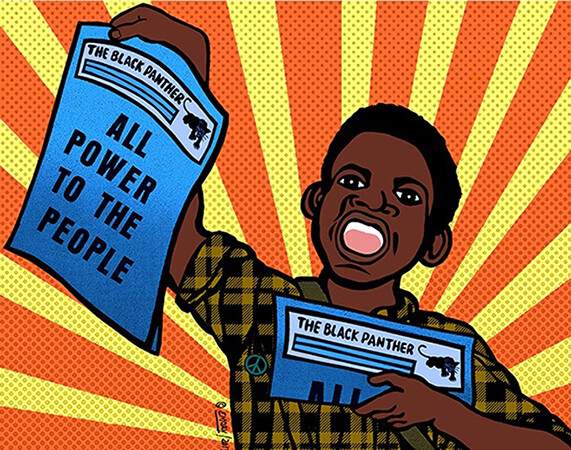Emory Douglas
Freedom Is A Constant Struggle
August 12–December 15, 2017
Opening: Saturday, August 19, 7pm
Laveronica arte contemporanea
via Grimaldi 93
97015, Modica, Sicily
To celebrate its tenth anniversary, Laveronica Arte Contemporanea is delighted to present the exhibition Freedom Is a Constant Struggle by Emory Douglas, an artist who has tied his name to the Black Panther Party and who made militancy for civil rights and the battle to free the oppressed its raison d’être. His works have inspired and influenced the iconic and symbolic imagination of many third-world liberation movements in Latin America, Asia and Africa. More recently, they have become a benchmark for the street-art culture.
To fully understand the essence of his art, we must reconsider the original context in which it took form.
In Oakland, California, in 1966, seething anger broke the chains of reform and non-violence preached by Martin Luther King Jr. and was funnelled into a revolutionary movement closer to the ideas of Malcolm X of the Black Panther Party. It proposed a broad platform of demands to be implemented in the final analysis also with force, and it advocated the use of weapons as a deterrent against abuse by the police. It is no accident that the movement chose a noble and courageous animal—the black panther—as its symbol, as it represents strength and dignity. The biographies of the party founders are quite similar. They grew up in dingy, ramshackle buildings, houses made of wood or brick where steep metal fire escapes expressed a sense of transience and flight; they had known hunger and poverty, drugs and alcohol, and a hatred for white policemen and prisons. Behind bars, they learned to study and read the books of Marcuse and Mao Zedong, the classics of economics and philosophy, the codes of civil and criminal law. Once they got out of prison, they became aware of their ideological power and became organized politically.
Emory Douglas’s case was the same: he grew up in poverty in the black slums of San Francisco, spent time in juvenile detention centres, and attended graphics courses at City College of San Francisco and San Francisco State, until he joined the Black Panther Party in 1967 at the age of 24. He became the party’s Minister of Culture and art director of The Black Panther, the party’s official newspaper, a weekly with a circulation of thousands of copies between 1967 and 1976. He can be credited with translating the party’s revolutionary ideals into cover illustrations and cartoons, summing up the articles of political analysis published in the weekly as direct and immediate graphic representations for a black community with a high illiteracy rate. The illustrations hinged not only on specifically racial topics, but more generally on the concept of empowerment, the fight against poverty, discrimination, imperialism, immigration policy, freedom for political prisoners, better working conditions in industrial “prisons”, the collective organization of free lunches, health care and schools for the lower classes.
The aim of images of policemen as pigs, politicians and judges as rats, black women with rifles slung over their shoulders and carrying babies, threatening-looking armed young people in the typical black leather uniform and berets of the Black Panthers, with machine guns and cartridge belts, and figures against the background of the socialist-communist rising sun was to debunk the power of the oppressor and instead build a mythology of the movement and its militants by openly challenging the establishment, with an attitude that spurred the black population to take pride, fight and pose resistance. Douglas’s art endured even after the Black Panther Party disbanded in 1982, and today it represents a corpus of thousands of images, posters, comics, collages and photomontages, which in the contemporary collective imagination forms one of the most powerful visual interpretations of the struggle.
In the email correspondence that preceded the organization of the exhibition, we suggested that Douglas entitle it Where Is Freedom? We felt it was important to ask that question, especially because now many conquests of the past have been called into question again. His answer was immediate and revealing. Freedom Is a Constant Struggle: this is the title he wanted for the exhibition. As is the case with collective art, Douglas asked us to bring together a community of local artists to contribute to the execution of some of his murals at the gallery. There will also be posters, videos and a series of original magazines of the Black Panther Party. The exhibition will also include a series of side events—the collective organization of free lunches in collaboration with the Maria SS. del Rosario Day Centre for Juveniles in Scicli, a conference and a closing celebration that will feature Emory Douglas, our special guest, to whom we feel strongly tied by a special sense of kinship and profound admiration.


